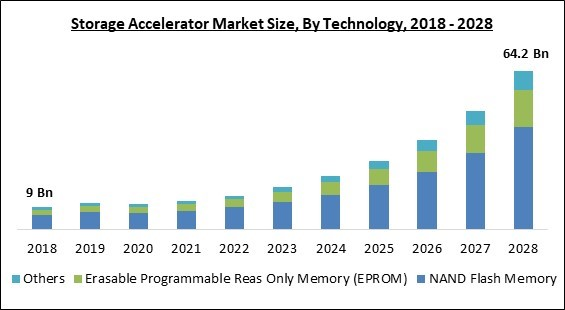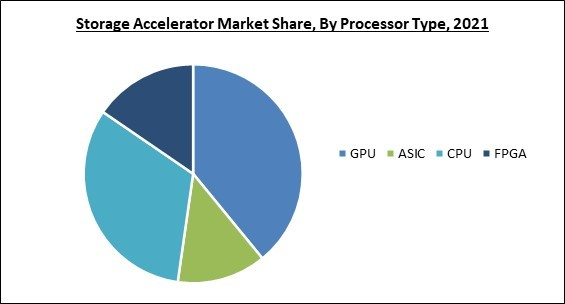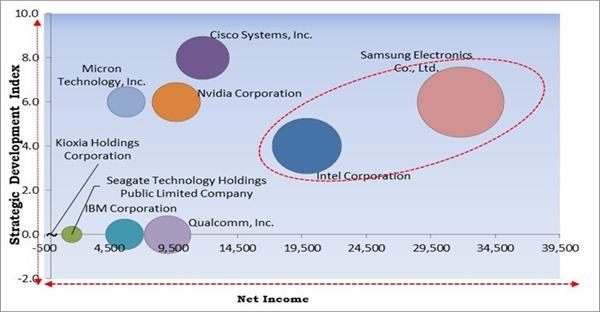The Global Storage Accelerator Market size is expected to reach $64.2 billion by 2028, rising at a market growth of 29.4% CAGR during the forecast period.
A storage accelerator is known as a high-performance PCIe (peripheral component interconnect express) card-based solid-state storage solution. Generally, a quick solid-state memory is utilized as the storage medium in storage accelerators, eliminating the mechanical latency and sluggish read/write performance of conventional mechanical storage devices.
Compared to parallel buses like PCI and PCI-X, storage accelerator type of PCIe offers lower latency and faster data transfer speeds. Each piece of hardware that is linked to a motherboard through a PCIe link has a unique point-to-point connection. As a result of not utilizing the same bus, devices are not contending for bandwidth.
Storage accelerators, graphics adapter cards, NICs, and other high-performance peripherals are examples of peripherals that use PCIe for data transport. Data is transmitted through two signal pairs, two wires for sending and the other two for receiving when using PCIe. A lane is a collection of signal pairs that may send and receive eight-bit data packets back and forth between two places.
The storage accelerator offloads transmission control protocol (TCP)/internet protocol (IP) computation from a processor. Applications run more quickly owing to storage accelerators since the microprocessor is hardly weighed down by TCP/IP processing. Additionally, it offers significantly better network performance at a reduced cost. In a storage area network (SAN), these storage accelerators can improve throughput, decrease lag, and lower overhead expenses.
The major strategies followed by the market participants are Product Launches. Based on the Analysis presented in the Cardinal matrix; Intel Corporation and Samsung Electronics Co., Ltd. are the forerunners in the Storage Accelerator Market. Companies such as Cisco Systems, Inc., Micron Technology, Inc., Nvidia Corporation are some of the key innovators in Storage Accelerator Market.
The market research report covers the analysis of key stake holders of the market. Key companies profiled in the report include Cisco Systems, Inc., IBM Corporation, Intel Corporation, Kingston Technology Company, Inc., Micron Technology, Inc., Nvidia Corporation, Qualcomm, Inc., Samsung Electronics Co., Ltd., Seagate Technology Holdings Public Limited Company and Kioxia Holdings Corporation.
A storage accelerator is known as a high-performance PCIe (peripheral component interconnect express) card-based solid-state storage solution. Generally, a quick solid-state memory is utilized as the storage medium in storage accelerators, eliminating the mechanical latency and sluggish read/write performance of conventional mechanical storage devices.
Compared to parallel buses like PCI and PCI-X, storage accelerator type of PCIe offers lower latency and faster data transfer speeds. Each piece of hardware that is linked to a motherboard through a PCIe link has a unique point-to-point connection. As a result of not utilizing the same bus, devices are not contending for bandwidth.
Storage accelerators, graphics adapter cards, NICs, and other high-performance peripherals are examples of peripherals that use PCIe for data transport. Data is transmitted through two signal pairs, two wires for sending and the other two for receiving when using PCIe. A lane is a collection of signal pairs that may send and receive eight-bit data packets back and forth between two places.
The storage accelerator offloads transmission control protocol (TCP)/internet protocol (IP) computation from a processor. Applications run more quickly owing to storage accelerators since the microprocessor is hardly weighed down by TCP/IP processing. Additionally, it offers significantly better network performance at a reduced cost. In a storage area network (SAN), these storage accelerators can improve throughput, decrease lag, and lower overhead expenses.
COVID-19 Impact Analysis
The semiconductor and electronics industries have suffered severely as a result of the COVID-19 outbreak. Due to an increase in COVID-19 occurrences, businesses and manufacturing facilities worldwide were closed. The supply chain was disrupted by partial or total lockdown, making it difficult for producers to access their customers. The COVID-19 outbreak also affected society and the global economy. The crisis led to decreased corporate confidence, a significant slowdown in the supply chain, and growing panic among some client segments. It also caused uncertainty in the share market. However, the recent growth in the fast implementation of HPC systems would positively affect the storage accelerators market.Market Growth Factors
Increasing demand for energy efficient storage accelerators
Every year, the size of applications and problems grows substantially, producing a massive volume of data that needs to be handled. This results in significant energy and power usage. Therefore, one of the main issues being handled in industry and research is the capacity to combine the programs in an energy-efficient manner. As a result, in recent years, energy efficiency has grown in significance as a performance indicator. The essential characteristics of storage accelerators that encourage big data analytics are efficient energy consumption and parallelism.Driven by the expansion of cloud-based services
Cloud-based deep learning services are lowering the up-front costs of conducting commercial operations and decreasing the need for server maintenance work. The rising requirement for AI-based processing has led an increasing number of tech and startups companies to start providing ML as a cloud service. In order to adapt deep learning within their own business demands, the majority of businesses and entrepreneurs do not create their own specialized hardware or software. Small and midsized organizations that consider on-premises alternatives to be more expensive may consider cloud-based solutions.Market Restraining Factors
Decreasing storage accelerator demand because of lack of hardware experts in AI
As artificial intelligence (AI) is a complicated system, businesses need employees with specific skill sets to design, manage, and implement AI systems. People working with AI systems, for instance, should be knowledgeable about technologies like deep learning, image recognition, ML and equipment intelligence, and cognitive computing. Additionally, it is a challenging undertaking that demands for well-funded internal R&D and patent filing to successfully integrate AI technologies with current systems.Technology Outlook
On the basis of technology, the storage accelerator market is divided into NAND flash memory, Erasable Programmable Read Only Memory (EPROM), and others. The EPROM segment recorded a substantial revenue share in the storage accelerator market in 2021. A form of programmable read-only memory (PROM) chip known as an EPROM, or erasable programmable read-only memory, preserves its data even when its power source is turned off. Non-volatile computer memory is capable of retrieving data even after a power source has been switched off and back on.Processor Type Outlook
Based on processor type, the storage accelerator market is categorized into CPU, GPU, ASIC, and FPGA. The GPU segment garnered the highest revenue share in the storage accelerator market in 2021. Numerous methods (erasure coding, content addressability, online data similarity detection, integrity checks, and digital signatures) that improve the dependability, scalability, and/or efficiency of distributed storage systems produce computational overheads that frequently make them difficult to use on today's hardware.Application Outlook
On the basis of application, the storage accelerator market is segmented into high-performance computing, data center servers, and others. The high-performance computing segment procured a significant revenue share in the storage accelerator market in 2021. Data is the fuel for game-changing inventions, the source of ground-breaking scientific discoveries, and the improvement of billions of people's quality of life worldwide. Advancements in science, industry, and society all rest on HPC.Enterprise Size Outlook
Based on enterprise size, the storage accelerator market is bifurcated into large enterprises and small & medium enterprises (SMEs). The large enterprise segment acquired the maximum revenue share in the storage accelerator market in 2021. The demand for more dynamic, more adaptable network services is being driven by the expansion of cloud-based computing, storage, and microservices-based applications. This is especially true for big businesses that run dozens or even hundreds of branch locations. The complexity and expense of operating WANs increase along with the expansion of users and locations.Regional Outlook
Based on region, the storage accelerator market is analyzed across North America, Europe, Asia Pacific, and LAMEA. The North America segment witnessed the largest revenue share in the storage accelerator market in 2021. This is mainly due to the increase in hyper-scale data centers, which are now the most prevalent in the globe and are experiencing rapid growth in respect of big data and traffic. For the major market participants, the rising number of data centers in various countries including the US and Canada is opening up attractive chances.The Cardinal Matrix - Storage Accelerator Market Competition Analysis
The major strategies followed by the market participants are Product Launches. Based on the Analysis presented in the Cardinal matrix; Intel Corporation and Samsung Electronics Co., Ltd. are the forerunners in the Storage Accelerator Market. Companies such as Cisco Systems, Inc., Micron Technology, Inc., Nvidia Corporation are some of the key innovators in Storage Accelerator Market.
The market research report covers the analysis of key stake holders of the market. Key companies profiled in the report include Cisco Systems, Inc., IBM Corporation, Intel Corporation, Kingston Technology Company, Inc., Micron Technology, Inc., Nvidia Corporation, Qualcomm, Inc., Samsung Electronics Co., Ltd., Seagate Technology Holdings Public Limited Company and Kioxia Holdings Corporation.
Strategies Deployed in Storage Accelerator Market
- Jul-2022: Samsung Electronics unveiled Samsung GDDR6, a 16-gigabit (Gb) Graphics Double Data Rate 6 (GDDR6) DRAM. The product features processing speeds of up to 24-gigabit-per-second. With the sampling of this product, the company plans to employ the DRAM on GPU platforms to introduce it to the market in time to cater to the rising demands.
- Mar-2022: Nvidia acquired Excelero, a provider of high-performance block storage. Through this acquisition, the company aimed to incorporate Excelero, technology into its company software stack. The acquisition helped Nvidia in diversifying its asset portfolio as it further extends its reach into integrated software and systems.
- Mar-2022: Intel Corporation acquired Granulate Cloud Solutions, an Israel-based real-time continuous optimization software developer. With this acquisition, Intel focused on helping data center and cloud customers reduce cloud and infrastructure costs, while simultaneously, maximizing their compute workload execution.
- May-2021: Samsung Electronics introduced a memory module exhibiting the Compute Express Link (CXL) standard for interconnections. The product is a memory solution based on DRAM which works on the CXL interface. The CXL-based module will play an important role in serving applications that are data-intensive including ML and AI in cloud ecosystems and data centers.
- Aug-2020: Cisco took over ThousandEyes, a network intelligence company. Through this acquisition, Cisco focused on strengthening its application and network performance by integrating ThousandEyes' internet visibility. The combination enabled customers to have end-to-end visibility of the digital delivery of services and applications across the internet, which allowed users to find out deficiencies and then enhance application and network performance across cloud networks and enterprises.
- May-2020: NVIDIA collaborated with Apache Spark, an open-source unified analytics engine. With this collaboration, NVIDIA focused on integrating Apache Spark 3.0, a big data processing analytics engine that is used by more than 500,000 data scientists worldwide, with end-to-end GPU acceleration. Furthermore, Databricks, a company founded by Apache Spark's creators, together with NVIDIA employed the RAPIDS software to Spark 3.0 to bring GPU acceleration to machine learning and data science workloads which were operating on Databricks across finance, healthcare, and retail among many other sectors.
- Feb-2020: Micron Technology collaborated with Continental, a German multinational automotive parts manufacturing company. Following this collaboration, the companies aimed at adapting a deep learning accelerator from Micron for the advanced machine learning (ML) applications of the automotive sector. The collaboration facilitated the creation of a smart edge-inference solution that utilized ML and offered the scalability, high performance, and low power that the automotive industry needs.
- Oct-2019: Micron Technology took over FWDNXT, a software and hardware business. Through this acquisition, the company aimed to assemble memory, computing, software, and tools into a comprehensive platform built for AI development. The platform offered the prominent building blocks needed to explore ingenious memory optimized for AI workloads.
- Jun-2019: Cisco acquired Sentryo, a French cybersecurity company. With this acquisition, Cisco aimed at integrating its networking architecture based on intent with Sentryo’s platform. By doing this, Cisco helped companies in deploying IoT by resolving the problems that arise during their implementation and also enabled them to manage more users and devices.
Scope of the Study
By Technology
- NAND Flash Memory
- Erasable Programmable Reas Only Memory (EPROM)
- Others
By Processor Type
- GPU
- ASIC
- CPU
- FPGA
By Application
- Data Center Servers
- High-Performance Computing
- Others
By Enterprise Size
- Large Enterprises
- SMEs
By Geography
- North America
- US
- Canada
- Mexico
- Rest of North America
- Europe
- Germany
- UK
- France
- Russia
- Spain
- Italy
- Rest of Europe
- Asia Pacific
- China
- Japan
- India
- South Korea
- Singapore
- Malaysia
- Rest of Asia Pacific
- LAMEA
- Brazil
- Argentina
- UAE
- Saudi Arabia
- South Africa
- Nigeria
- Rest of LAMEA
Key Market Players
List of Companies Profiled in the Report:
- Cisco Systems, Inc.
- IBM Corporation
- Intel Corporation
- Kingston Technology Company, Inc.
- Micron Technology, Inc.
- Nvidia Corporation
- Qualcomm, Inc.
- Samsung Electronics Co., Ltd.
- Seagate Technology Holdings Public Limited Company
- Kioxia Holdings Corporation
Unique Offerings
- Exhaustive coverage
- The highest number of Market tables and figures
- Subscription-based model available
- Guaranteed best price
- Assured post sales research support with 10% customization free
Table of Contents
Chapter 1. Market Scope & Methodology
Chapter 2. Market Overview
Chapter 3. Competition Analysis - Global
Chapter 4. Global Storage Accelerator Market by Technology
Chapter 5. Global Storage Accelerator Market by Processor Type
Chapter 6. Global Storage Accelerator Market by Application
Chapter 7. Global Storage Accelerator Market by Enterprise Size
Chapter 8. Global Storage Accelerator Market by Region
Chapter 9. Company Profiles
Companies Mentioned
- Cisco Systems, Inc.
- IBM Corporation
- Intel Corporation
- Kingston Technology Company, Inc.
- Micron Technology, Inc.
- Nvidia Corporation
- Qualcomm, Inc.
- Samsung Electronics Co., Ltd.
- Seagate Technology Holdings Public Limited Company
- Kioxia Holdings Corporation
Methodology

LOADING...











